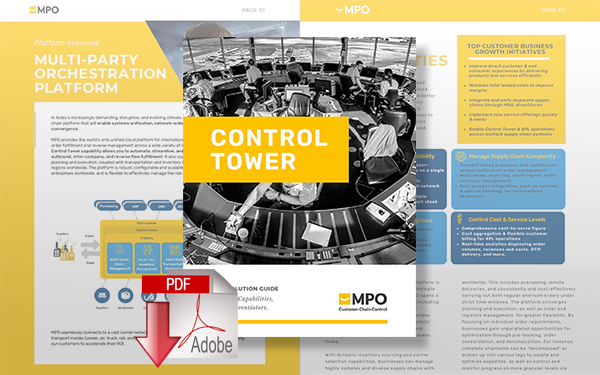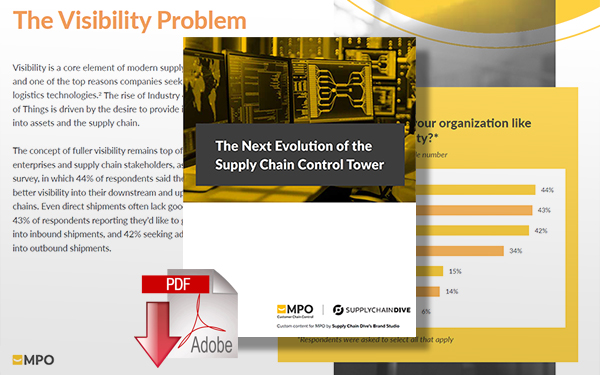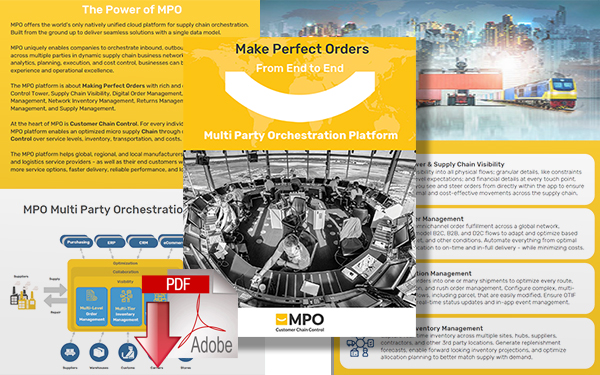5 Critical Trends for Supply Chain Control Towers in 2022

In this article, we describe a few of the most exciting and critical supply chain control tower trends in 2022 that help build flexibility, agility, and resilience.
Control Tower Technology
Supply chain management has become increasingly complex and involves more coordination among network partners.
Control tower technology was introduced to provide greater visibility and more efficient collaboration within the evolving ecosystem.
Over time, the technology has adapted from a narrow solution that spanned transportation management to a more comprehensive and holistic capability to fit the growing demand for wider system integration, efficiency, intelligence, and speed.
Here are a few of the most exciting and critical supply chain control tower trends in 2022 that help build flexibility, agility, and resilience.
5 Features of a Successful Supply Chain Control Tower
1. No Disjointed Legacy Apps
According to 2021, Gartner Supply Chain Technology User Wants and Needs Survey, 55% of chief supply chain offers (CSCOs) said their primary organizational focus is integration across core supply chain processes and the extended value chain.
Why is it so important to shift from a portfolio-based environment to a natively-unified, single-platform control tower?
Multiple separate entities, including, for example, material suppliers, contract manufacturers, VMI specialists, LSPs, warehouses, reverse logistics specialists, and carriers, may all contribute to one supply chain, resulting in a complex network of partners, each with their own individual data infrastructure spread across multiple ERPs and warehouse management systems, among others.
When all these partners deploy separate business applications, it’s easy for information to become siloed, and there are fewer opportunities to collaborate on objectives, improve operations, and track granular costs. There are also bound to be integration errors and data redundancies that could compromise the integrity and quality of the data that’s used for strategic decision-making.
A supply chain control tower as part of a multi-party orchestration platform removes segmentation and helps streamline processes across organizations. By centralizing data and eliminating silos, the control tower makes a complex, multi-tiered process easier to monitor and control. It can accept orders from multiple ERPs, offer actionable visibility across inventory, orders, and transport, and lay the foundation for intelligence and optimization across inbound, outbound, and reverse flows.
2. True End-to-End Visibility
Visibility is one of the most crucial aspects of a supply chain control tower, not just when it comes to transportation, but also when it comes to inventory, logistics, and warehouse activities. Returns management and reverse logistics, for example, are typically managed separately from downstream business flows; as a result, opportunities to provide full order visibility to customers are lost which would impact serviceability to them.
With end-to-end visibility, flows can be multi-directional and adapted to fit order specifications and various service levels. Broad-scale insights about the product’s availability and life cycle can also be gleaned by looking at granular and holistic views of supply chain operations, which means CSCOs will have better quality data to base their decisions on.
3. In-App Solutions
Early control tower solutions were essentially visibility dashboards - they provided insight and analytics tracking, but most operations still had to be executed manually. If the corresponding parties used different ERP programs, viewing and changing an order might require logging into separate systems or contacting a representative directly over the phone or email. These processes are time-consuming, disjointed, and don’t typically lead to immediate resolutions.
In contrast, the next generation of control towers are significantly improved and enables swift resolutions. They offer in-app functionality, which means users can execute changes within the SCM/SCP software, thereby reducing how much time is needed to monitor and modify orders as needed.
4. Sustainability Objectives and GHG Monitoring
In response to a growing demand for “green” initiatives, control tower platforms can now incorporate greenhouse gas (GHG) emissions into supply chain planning. For example, users may input parameters about an order, then optimize the product flow based on EN 16258 standards and the GLEC framework. Supply chain partners can also be scored by GHG emissions, fuel efficiency, and other non-monetary weighted values to facilitate the partner selection process.
Additionally, control towers as part of multi-party orchestration platforms can help logistics teams plan and execute all flows against the lowest carbon footprint, as well as take various steps to minimize impact and monitor progress to continuously improve and meet sustainability goals.
5. Embedded Intelligence, Data Science, and Machine Learning
Supply chain control tower systems that are integrated network-wide have access to a pool of data that is continuously growing and becoming more reliable. When updates occur in real-time from multiple data pipelines, the information is often more representative of actual conditions. Data science and machine learning make it possible to aggregate data then apply the information to strategy and planning.
Digital supply chain twins are an example of one-way machine learning that can be used to facilitate decision-making - through model simulation, CSCOs can optimize flows and networks virtually before implementing any changes in the real world.
Bringing Everything Together Through Single-Platform Optimization
Just like the dual spheres of supply and demand, control tower solutions are constantly evolving. To manage disruptions and optimize operations in a reality that is rife with uncertainty and risk, organizations need a supply chain control tower that supports network-wide integration for E2E visibility that provides one version of the truth across the ecosystem.
Further, information is only as good as what you can do with it – and how quickly. In-app functionality is critical for timely and data-driven decision-making that helps teams maintain the highest service levels at the lowest possible cost. Next-generation supply chain control towers also enable growth in digital transformation and maturity, with capabilities for GHG monitoring, machine learning, and scaling to efficiently and effectively meet growing reverse logistics needs, omnichannel fulfillment needs, and beyond.
The MPO Supply Chain Control Tower enables seamless systems integration across the multi-party network, enabling end-to-end supply chain visibility and in-app control. With an embedded layer of intelligence and machine learning capabilities, businesses are empowered to solve immediate pain points today, while also leveraging predictive analytics to future-proof against tomorrow's challenges.
Why a Natively Unified Platform?
Cloud and SaaS technologies have made extraordinary strides toward breaking down the silos that limit effective, networked collaboration. But since most “supply chain suites” are the result of mergers and acquisitions, the impression of ‘unity’ they offer is frequently deceiving.
In contrast, a natively unified platform offers supply chain capabilities - such as order and transport management, as well as visibility and control over these functions - on a single platform. All supply chain solutions, such as OMS, TMS, Reverse Logistics, and Spare Parts Management, are designed from the ground up to organically communicate, share data, and converge processes for maximal speed and optimization.
Learn more about how the platform can support your digital transformation initiatives by downloading a copy of the Control Tower and Visibility Solution Guide below. You can also reach out to [email protected] or request a demo today.
Related 'Control Tower' Resources
Supply Chain Control Tower & Visibility
This Supply Chain Control Tower and Visibility solution guide provides a deeper look into the platform's capabilities and benefits, as well as a practical overview of why a unified and converged approach will make all the difference in running an efficient and cost-effective supply chain that drives superior customer satisfaction. Download Now!
The Next Evolution of the Supply Chain Control Tower
This white paper explores why visibility is a core element of modern supply chain digitization, and a top reason to implement logistics technologies in your supply chain. Download Now!
Multi-Party Orchestration Platform
In this brochure, you'll find a guide to MPO's unified cloud platform for multi-party orchestration, including its rich and flexible solutions: Control Tower, Supply Chain Visibility, Digital Order Management, Transportation Management, Network Inventory Management, Returns Management, Spare Parts Management, and Supply Management. Download Now!
More Resources from MPO
MPO News: MPO + Metafora Announce Partnership to Make Supply Chain Visibility Easier
Article Topics
MPO News & Resources
TMS+ Go Beyond Transport to Optimize Cost, Service, & Resiliency Multi-Party Orchestration Platform When It Comes to Digital Transformation You May Not Be Doing What You Think How Chief Operating Officers are Achieving Results with Supply Chain Software SPARK Matrix Transportation Management System Software Analyst Report Top Trends Driving Change and Technology Strategy Within Logistics & Transportation Management 5 Key Steps for Optimizing your Last Mile Delivery More MPOLatest in Transportation
Biden Expands Tariffs on Chinese Imports Amid Fair Trade Concern Assessing the freight recession and truckload market with Mike Regan, TranzAct Technologies Baltimore Bridge Collapse: Dali Cargo Ship Finally on the Move Can High School Students Solve One of Trucking’s Biggest Problems? DP World Expands Freight Network with New Texas Offices UPS Cuts Email Response Time in Half with AI Automation Five Innovations Shaping the Future of Last-Mile Delivery More Transportation

















